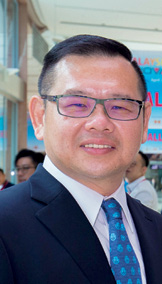There is a need for more awareness on the increasing prevalence of myopia in Malaysia.
Vice President of the Association of Malaysian Optometrists (AMO) Cheah Wen Tye who is an optometrist from Eyecon Midvalley, and President of the Malaysian Association of Practising Opticians (MAPO) Edmund Teng who is an optician from Bond Optometry Sdn Bhd, feel that there should be active involvement of all parties in educating the public, especially the younger age group.

 Both Cheah and Teng, an optometrist and an optician respectively, lamented that the awareness level on eye diseases among the public was quite low.
Both Cheah and Teng, an optometrist and an optician respectively, lamented that the awareness level on eye diseases among the public was quite low.
Groups affected by myopia

Cheah said: “Based on previous studies, we can say that myopia cases in Malaysia have been increasing over time.
“Myopia can come at any age, whether to a child, teen or adult.”
Teng added that in recent times myopia has developed at a much younger age, as young as three years old.
He continued: “Apart from age, studies have also shown that certain ethnicities are more prone to be myopic compared to others.
“So, irrespective of age and ethnicity, myopia is indeed a public health issue.”
Said Cheah: “Many assume that myopia only affects the vision and is
about wearing another type of glasses. However, progression of myopia
needs to be monitored annually because high myopia will start to damage the inside of the eye, not just the vision.”
Why myopia is more common now

Genetics was initially the main contributing factor for the development and progression of myopia some time back.
But in recent times, Teng said, lifestyle and environment factors are the main contributing factors for myopia.
“Nowadays everything is indoors, with prolonged near work and increased screen time on digital devices.”
He added that with the lockdowns and Movement Control Orders (MCOs), adapting to the new lifestyle, working from home and online classes have increased digital devices screen time exponentially. And with the lack of outdoor activities, myopia is most likely to progress faster.
“During this pandemic, we can see some children with myopic progression of -1 diopter in just three months, which was mostly unheard of previously,” said Cheah, as observed in his practice.
Foreseeable risks of myopia
Cheah noted that undetected and uncontrolled myopia is a sight threatening condition.
“When the myopia progresses further, with -5 diopters and above, there is risk of developing other eye diseases and problems such as retinal tear or detachment.
Teng added that myopia will also affect one’s productivity and lifestyle and stressed that early detection and correction is crucial to avoid these risks.
Profession development and eye care awareness
Formed in 1984, AMO unites optometrists throughout the country to promote the advancement of the science of optics in its application to the preservation of sight.
MAPO was established in1985 and provides opportunities to its members and eye care practitioners to upgrade knowledge and skills through various activities.
Both AMO and MAPO conduct Continuing Professional Development (CPD) programmes for optometrists throughout Malaysia to upgrade their skills and update on the latest technologies from around the world.
Since its inaugural event in 2016, the National Eye Health Awareness (NEHA) campaign has been AMO’s major event in collaboration with Johnson & Johnson Vision Care and Essilor Malaysia Sdn Bhd.
“Throughout the campaign, we focus on public education and awareness programmes. This year, we will be having our first virtual NEHA, titled ‘Eyes under lockdown’ to be announced soon.”
According to Teng, MAPO also work closely with the Malaysia Society of Ophthalmology (MSO), industry partners and suppliers on the latest updates on eye diseases, products and equipment developments.
“We also work with NGOs and universities to create awareness and conduct public eye screening,” added Teng, who runs his optometry business with his wife who is an optician and daughter, an optometrist.
Teng stated: “We need to be more aggressive in promoting awareness on myopia and other eye diseases in the mass media and social media.
“We also need the active involvement and action from all parties, from the government down to schools and families. Everyone has their part to play in educating the public, especially the younger age group.” — The Health








